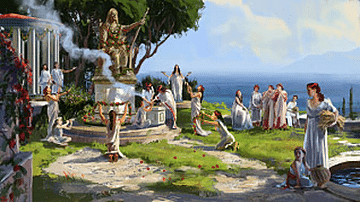
Minerva was the Roman goddess of wisdom, medicine, commerce, handicrafts, poetry, the arts in general, and later, war. In many ways similar to the Greek goddess Athena, she had important temples in Rome and was patron of the Quinquatras festival.
Originally, Minerva was an Italian goddess of handicrafts closely associated to the Greek goddess Athena. The scholarly consensus, however, is that Minerva was indigenous, passing to the Romans from the Etruscan goddess Menrva, and that her name derives from meminisse, meaning 'to remember'. Considered the daughter of Jupiter, from whose head she was born, the goddess was first worshipped in Rome as one of the Capitoline Triad along with Jupiter and Juno. In legend, the great hero Aeneas, who escaped from fallen Troy, brought a cult statue of the goddess to Rome. Residing within the Temple of Vesta it was believed that the city would be safe from harm as long as the statue was preserved. Like Athena, the goddess was renowned for her chastity, and she once famously refused the amorous advances of Mars, the god of war.
Minerva is the protagonist in one of the most famous stories presented in Ovid's Metamorphoses. In the myth, a Lydian girl named Arachne unwisely boasts that her weaving skills are even better than Minerva's. The great goddess was not best pleased to hear such claims and she promptly challenged the presumptuous Arachne to a weaving competition. Settling down at their respective looms the two ladies each set about creating a wonderful tapestry that would outshine their rival's best efforts. Minerva's masterpiece showed all the great gods and had Minerva herself taking centre-stage in the act of winning the competition with Poseidon to become patron of Athens. Even more ominously for Arachne the edges of the tapestry depicted all those mortals who had infamously challenged the gods and come a serious cropper. Meanwhile, Arachne's less pious work displayed various gods taking on different forms so that they could seduce unsuspecting mortals. The work itself was a truly magnificent piece of weaving but, perhaps predictably, Minerva, nevertheless, declared herself the winner and punished Arachne for her audacity by hitting her on the head three times and changing her into a spider. It is another cautionary tale, so common in Greek and Roman mythology, of how unwise it is for mortals to consider themselves the equals of the gods.
Perhaps the most important site of worship of Minerva was on the Aventine where a shrine was built in either 263 or 262 BCE. This particular incarnation of the goddess - Aventine Minerva - was of Greek origin and the site was also the location of a writers and actors guild and an important centre for craftsmen. The goddess also had a shrine on mons Caelius, one of the seven hills of Rome.
Over time, Minerva grew in stature within the Roman pantheon and she took over as the most important focus of the Quinquatrus festival, previously the domain of Mars. The five-day festival began on the 19th of March and marked the beginning of the campaign season for the Roman army. The goddess also became associated with victory, as illustrated by Pompey's dedication of a temple to the goddess following his successful campaigns in the east. The emperor Domitian also claimed the goddess was his special protectress and he commissioned a temple to her in the Nerva Forum in Rome in the second half of the 1st century CE.
One of the most impressive representations of Minerva in art is the 3 metre high statue of the goddess which now resides in the Capitoline Museums in Rome. Dating to the 2nd century BCE, the standing figure wears a chiton and belt, an aegis with Medusa, carries a shield on her left arm and wears a Corinthian helmet pushed to the back of the head. The statue, which owes much in composition to the colossal chryselephantine statue of Athena that Pheidias sculpted for the Parthenon in the 5th century BCE, presents the goddess in her familiar guise as a noble and fearless warrior.






